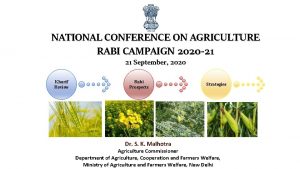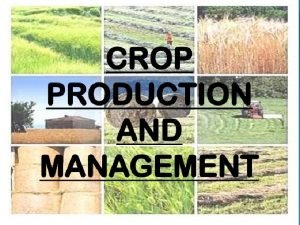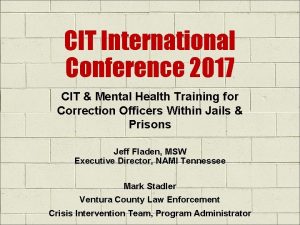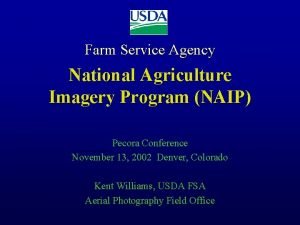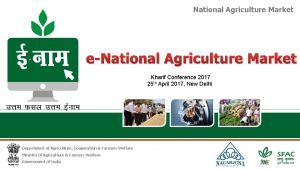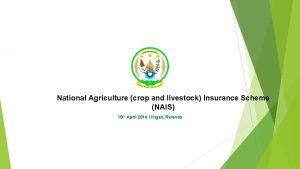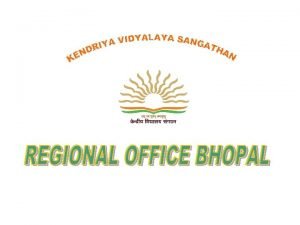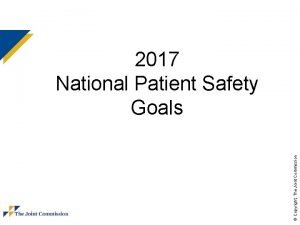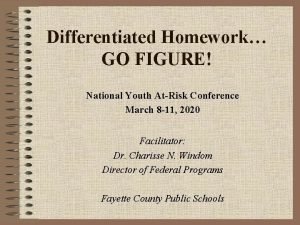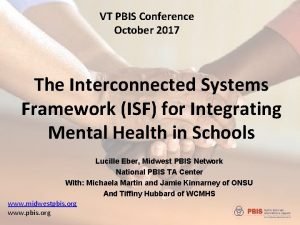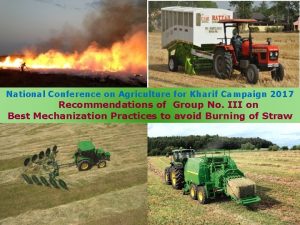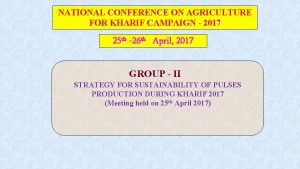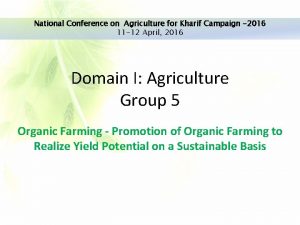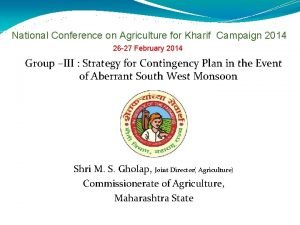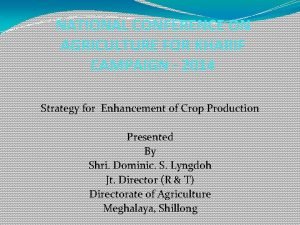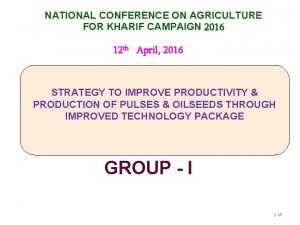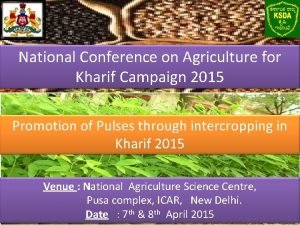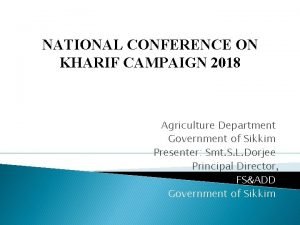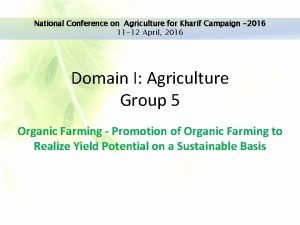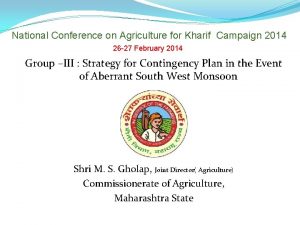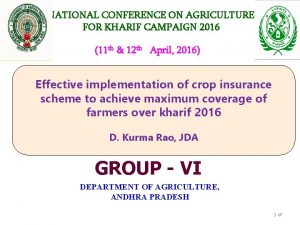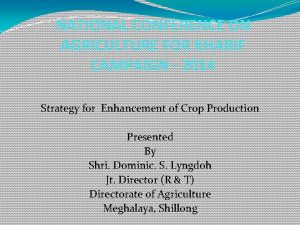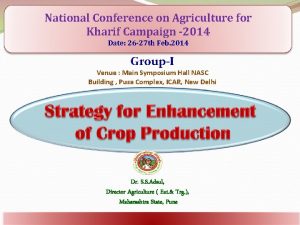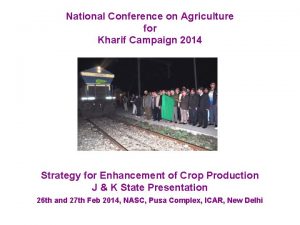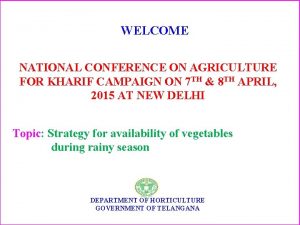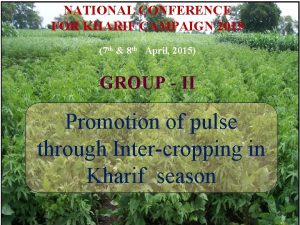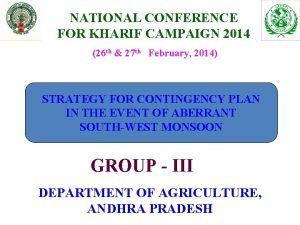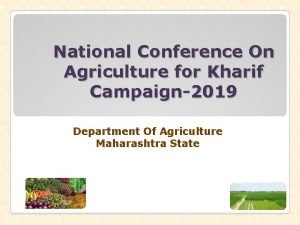National Conference on Agriculture for Kharif Campaign 2017





















- Slides: 21

National Conference on Agriculture for Kharif Campaign 2017 Recommendations of Group No. III on Best Mechanization Practices to avoid Burning of Straw

Participated States Bihar Chhattisgarh Haryana Madhya Pradesh Nagaland Punjab Rajasthan Tamil Nadu Uttar Pradesh West Bengal

Residue generated, residue surplus and burned in Major States (Source: National Policy for Management of Crop Residues) Million tonne S. N. States 1 Andhra Residue generation 43. 89 Residue surplus Residue burned 6. 96 Pradesh 2. 73 2 Bihar 25. 29 5. 08 3. 19 3 Chhattisgarh 11. 25 2. 12 0. 83 4 Gujarat 28. 73 8. 90 3. 81 5 Haryana 27. 83 11. 22 9. 08 6 Karnataka 33. 94 8. 98 5. 66 7 Madhya 33. 18 10. 22 Pradesh 6. 91 8 Maharashtra 46. 45 14. 67 7. 42 9 Orissa 20. 07 3. 68 1. 34 10 Punjab 50. 75 24. 83 19. 65 11 Rajasthan 29. 32 8. 52 1. 78

Pollution (Affecting Human health) & GH gases emission Smoke & soot particles Loss of Nutrients e. g. N, P, K&S Impacts of Crop Residue Burning Soil hardenin g& erosion due to no cover Mortality of active beneficial Soil Bacteria

Majority Residue Burned � State 1. Andhra Pradesh 2. Bihar 3. Chhattisgarh 4. Gujarat 5. Haryana 6. Karnataka 7. Madhya Pradesh 8. Maharashtra 9. Orissa 10. Punjab 11. Rajasthan 12. Tamil Nadu 13. Uttar Pradesh 14. West Bengal Crop Residue Paddy /Wheat /Paddy Wheat Paddy/Wheat/ Sugarcane Wheat Paddy/Wheat/ Sugarcane Wheat/ Paddy/Mustard Wheat/Paddy/Sugarcane Wheat

LOSS OF NUTRIENTS DUE TO PADDY STRAW BURNING (per ton basis) �Nitrogen 5. 5 kg �Sulphur 1. 2 kg �Phosphorus (~40%)2. 3 kg �Potash (~10%) 25. 0 kg �Organic Carbon 400 kg

Challenges? Ø Huge volume of crop residue; Ø Collection & Storage; Ø Time window between harvesting and sowing of two(next )crops; Ø Awareness, Dissemination of Technology, Capacity Building of Technical Manpower and those of farmers; Ø Cost-effective mechanization, appropriate machinery; Ø Utilization of crop residue; Ø Technology up-gradation availability of

Bio Char / gasification Fodder / Other purposes Direct seeding by zero-till or Happy Seeder Crop Residue Management Alternatives Incorporation in soil and Mulching/composting Baling/ Binder for domestic/industrial as fuel

Technological Interventions. Retention of Crop Residue as Mulch and Incorporation of in soil. Use of crop residue for compost/vermin-compost/FYM Crop residue utilization Mushroom Cultivation. for Incentivize purchase of improved machineries to ensure minimum left over of crop residue. Promotion of Custom Hiring/ Agriculture Service Centres Improvement in combine harvester for In-situ management and other mechanism for collection of crop residue

Diversified Uses of Crop Residue. Use in Power Generation, production of cellulosic ethanol in PPP mode. Use of Crop Residue for paper/board/panel and packing material Promotion of collection of crop residue for feed bricks making and its transport to fodder deficient areas.

Capacity Building and Awareness Generation. Organizing training of farmers for awareness generation through mass and print media. Establishment of Custom Hiring Centres through Self Help Group of unemployed youth by providing subsidy Demonstration of crop residue management technologies.

Straw Reaper Advantages • Recover wheat straw after combine operation • Recovered wheat straw is used as cattle feed. • The capacity of machine on The left over wheat stalks an average is 0. 4 ha/h and after cut by combine straw recovery is about 55 harvester, thresh and blow 60%. out the straw netted • The quality of to bhusa is trolley attached which allows comparable with that made blowing of dust particles. available thresher. • There is an additional grain recovery of 50 -100 kg/ha. Cost: Rs 2, 25, 000 (Approx)

A perfect machine for chopping all types of crop residue / straw such as wheat, Paddy, Maize, Sorghum, Sunflower etc. Paddy Straw Chopper In a single operation, it chops the left behind straw/ stubbles and spread it on the ground. The chopped and spreaded stubbles are easily buried in the soil by the use of single operation of Rotavator or disc harrow Subsequently, wheat sowing is done as usual by the use of , no-till drill or traditional drill/other equipment Machine consists of a rotary shaft mounted with blades named as flail to harvest the straw and chopping unit consisting of knives. Cost: Rs 2, 000 (Approx) Advantages • Reduce air pollution • Reduces fuel and labour costs.

Cost: Rs 35000 -40000 (Approx) Zero-till farming is a way of growing wheat / other crops without tillage or disturbing the soil in paddy/other crop harvested fields.

Happy Seeder is one of the unique techniques which is used for sowing seed without any burning of Crop residue. In this machine a Rotor unit is attached at front of seeding unit that cuts & spread straw in between the rows, as mulch. Majority of the residue is not disturbed and seed is sown in a single pass. This technology is eco friendly with environment for the health of soil as well as it also saves water. Cost : Rs 55000 (Approx)) Advantages Removes the need to burn rice stubble before planting wheat, therefore reducing air pollution. Direct sowing also reduces soil disturbance, enabling it to retain more nutrients, moisture and organic content. Saves money as less time is needed on carrying out field operations, which in turn reduces fuel and labour costs.

MULCHER MACHINE Used for mulching of straws of crops such as rice, maize, sunflower and tobacco residues easily The knives which are jointed on the roller, rotates vertically. This machine shreds the weeds and stock of row crops in orchards Cutting height is adjustable by two wheels at the back of the machine. Cost: Rs 1, 50, 000(Approx)

Hay Rake • It is used to collect & cut hay or straw into windrows for later collection (e. g. by a baler). • It is also designed to fluff up the hay and turn it over so that it may get dry. • It reduces the work of baler and in Cost: Rs 2, 70000/ (Approx)

Baler Advantage • Crop residues are turned into bales which is used for animal feeding as well as bio fuels. • Creates alternative business for farmers to sell bales to power plants. • Save the environment from air pollution. Cost: Rs 2, 25, 000 to 18, 00000(Approx)

The Super SMS cuts the straw in small pieces and scatters it around behind the tail of the combine. Super Straw Management System (Super SMS): An additional straw management system could be fitted to Self Propelled combine harvesters Advantages • Easy direct sowing of wheat with happy seeder • The scattered straw helps in conserving the soil moisture • Avoid burning straw or removal of straw.

GROUP’S RECOMMENDATIONS FOR PROMOTION OF RESIDUE MANAGEMENT MACHINERY • State Governments may be given full assistance for promotion through awareness by way of demonstration, training and capacity building • Higher slabs of subsidy may be given to farmers for procurement of machinery • More Custom hiring centres may be promoted for easy reach of costly equipment for small and marginal farmers at village level • Incentivize farmers for adoption of various residue management operations • Support for funding R&D/technological up-gradation to States • Strengthening of Agricultural Engineering Extension Services (Special Directorate of Agricultural Engineering) on the pattern of Madhya Pradesh and Tamil Nadu • Farm mechanization components in different schemes like NFSM, NMOOP, MIDH etc. be brought under single umbrella of SMAM for effective implementation and uniformity of assistance

Thank you
 National conference on agriculture for summer campaign
National conference on agriculture for summer campaign National conference for rabi campaign 2020
National conference for rabi campaign 2020 Ergot of bajra
Ergot of bajra Arma conference 2017
Arma conference 2017 Cit healthcare conference 2017
Cit healthcare conference 2017 Infor cloud suite
Infor cloud suite 2017 asco oncology practice conference
2017 asco oncology practice conference 2017 dvhimss annual fall conference
2017 dvhimss annual fall conference National agriculture imagery program
National agriculture imagery program Nmsa guidelines
Nmsa guidelines National agriculture market
National agriculture market National agriculture insurance scheme
National agriculture insurance scheme Kvs national sports meet 2018-19
Kvs national sports meet 2018-19 National patient safety goals 2017
National patient safety goals 2017 National youth at risk conference
National youth at risk conference Civil air patrol national conference
Civil air patrol national conference Aafp national conference
Aafp national conference Pbis national conference
Pbis national conference Vt pbis
Vt pbis Cdha national conference 2019
Cdha national conference 2019 National radiological emergency preparedness conference
National radiological emergency preparedness conference National business group on health conference 2018
National business group on health conference 2018

